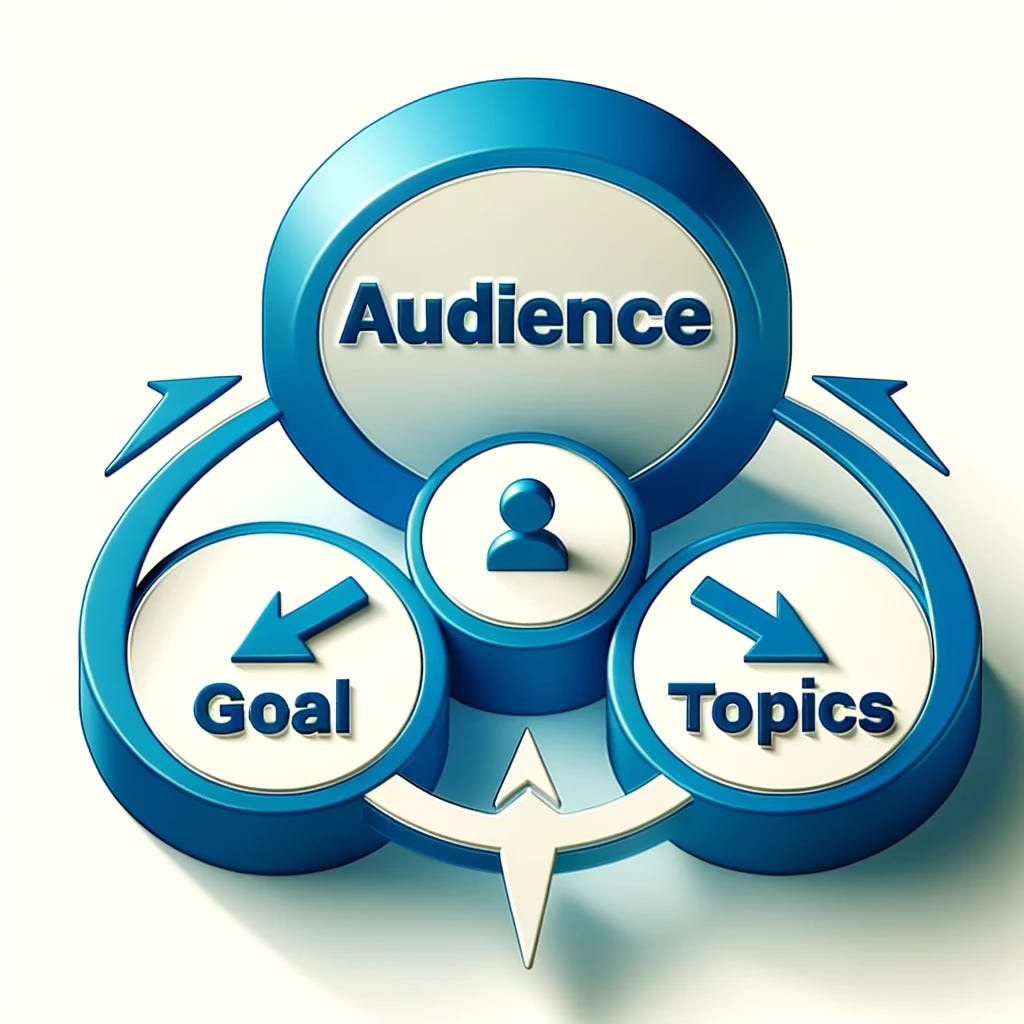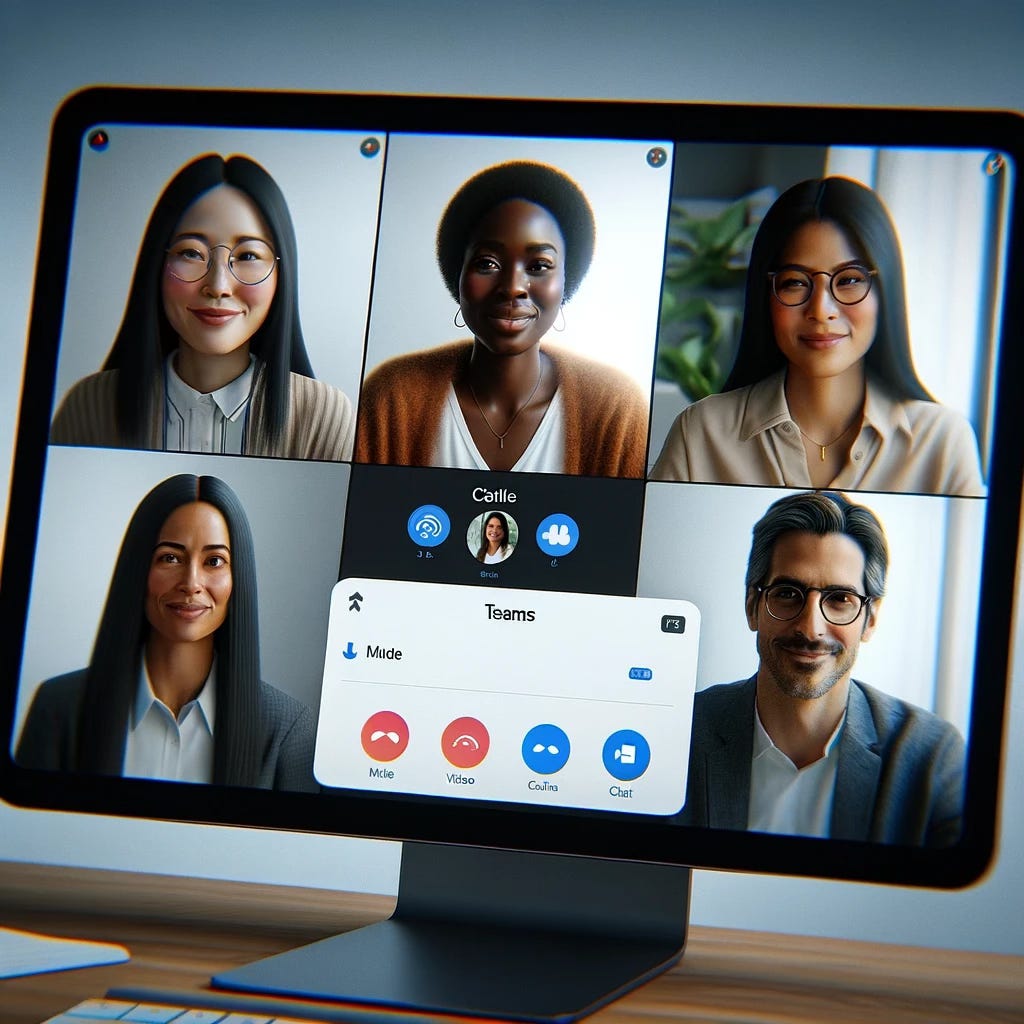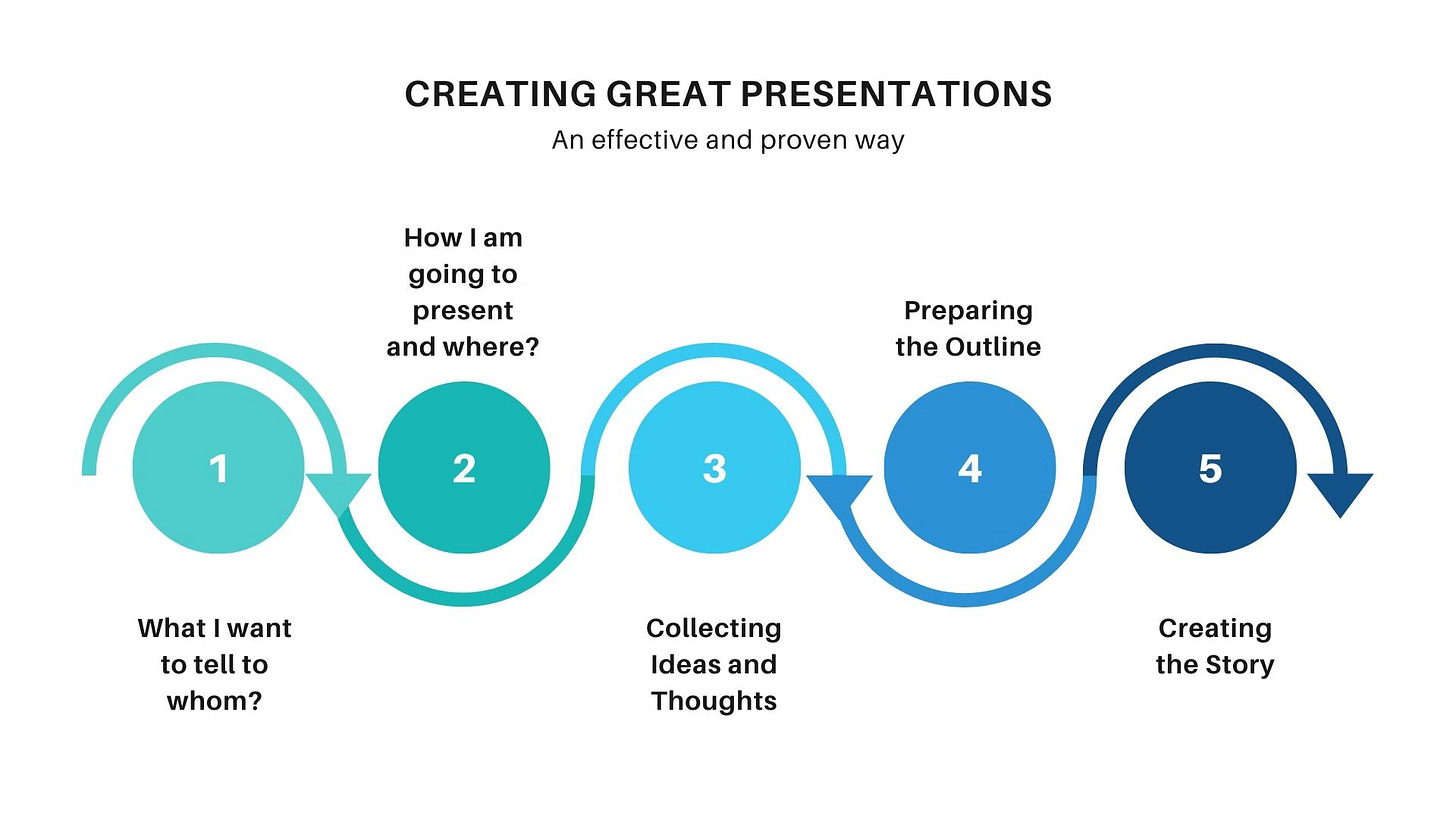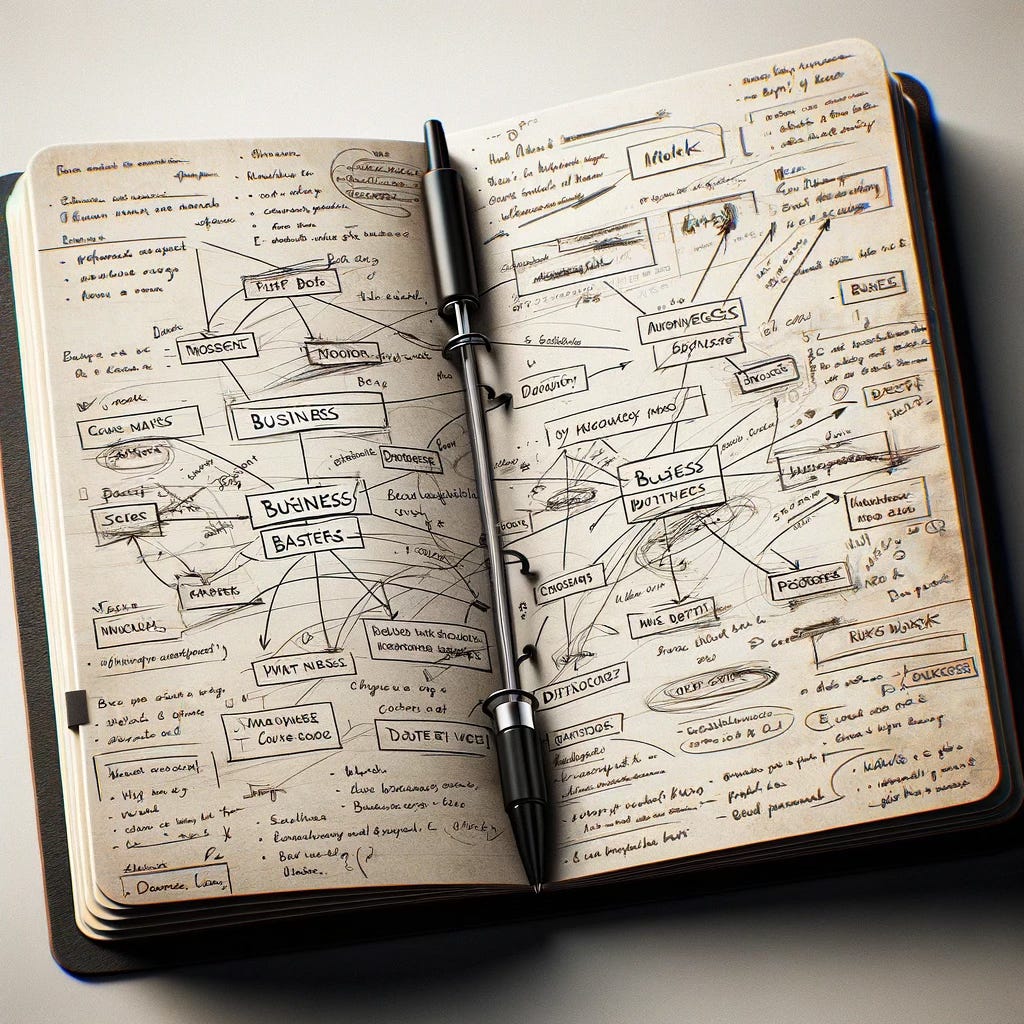Beyond Slides: A practical step-by-step guide to create great presentations (Part I)
The process I've used to deliver speeches that resonated with audiences and helped me achieve my goals
I’ve recently become a “Top Public Speaking Voice” on Linkedin. This recognition isn’t as difficult to obtain as you would imagine, but that’s a topic for another time. This badge inspired me to write about how to prepare a successful presentation, as many people have found my answers on Linkedin’s collaborative articles insightful.
Over my career, I’ve presented to diverse audiences, in many different countries and in four different languages. I’ve covered technical and business topics, and I’ve received recognitions due to my presentations. I believe I am an excellent presenter (If I don’t say it, who will?), and I’ve reached a high level of confidence when I deliver any sort of speech.
The foundation for my successful deliveries is a process I’ve developed over the years, an effective and proven way to organise the work needed to create outstanding presentations. I’d like to share it with you, to help you and inspire you if you want to improve your speeches, deliver great talks and achieve your goals.
Let’s go step by step, shall we?
What I want to tell to whom?
Whenever I need to convey a message to an individual or a large group of people, my first step is to understand who the audience is going to be, what are the topics I want them to hear from me, and what I want to achieve. Having a clear understanding of those three elements (audience, topics & goal) are the base for my process to create presentations.
When we talk about the audience, this is the people that will listen to my speech, and they have a reason to be there as well, their own goals. It’s important to understand that in advance, to know who they are, why they are there, and how many.
The goal of my presentation needs to be clear from the very beginning, and it should answer what I want to achieve, and what I want the audience to leave with at the end of it.
In most cases, you want the audience to buy something from you, a product or service, or you want to motivate and inspire them to do something that will be beneficial for you. That’s your goal. However, if you don’t focus also in what the audience will learn or experience during your presentation, you are only covering half of the goal.
Defining clearly both things, your goal and what you are going to give the audience that will be useful for them, will determine every topic you will include in your presentation and the way you are going to deliver it.
How I am going to present and where?
The next step is to know (or define, if it’s in your control) the channel that will be used to deliver the presentation. Some of the key questions to answer are:
Is the audience going to be on-site, remotely or both?
Is this going to be a small meeting with a few people or a talk for a large group?
What are the characteristics of the place where it is going to be presented?
Can I have a visual aid like a Powerpoint or will I need to use some other means?
How much time do I have to present?
The delivery channel for your presentation, the place, and the tools you are going to have available will define many things about how you are going to successfully convey your message and achieve your goals.
For instance, if the audience will be remote and you will be presenting online, you need to consider that many of them will be multi-tasking (Yes, that’s what people do - watch a webinar, answer emails and check messages on their phone, all at the same time) so they might not be watching your slides (if you have some) or even listening to you all the time.
If your audience is on-site, the size of the audience and of the meeting room or conference hall are going to determine aspects connected to the visual aids you can use. And, the time that you have allocated will also give you some constraints about how much you can talk.
In my case, I always like to make the presentation as short as possible, even shorter if the audience will be remote and I will be presenting online. It doesn’t matter if you have allocated an hour of time in the agenda to deliver your presentation, as most topics can be covered in a lot less time (unless is some educational topic that requires large amounts of content to be shared).
You must consider how much time the audience can stand listening to you, and how much time you really need to achieve your goal. Even if you are presenting about the same topic and want to achieve the same goal, you aren’t going to need the same time when talking to an audience of experts in your field than to other type of public.
Getting started
It only becomes the time to work on the actual presentation once I know all the above. If you start to work on the presentation before, you will most definitely need to make a lot of adjustments later, and creating a compelling and inspiring content is something that takes time and dedication.
In my case, I start as soon as I can and as far away as possible from the delivery date. To begin with, I write notes about everything that comes to my mind that i want to include in the presentation, before even creating the first slide. I collect as many thoughts as i can at once, on a paper notebook, and then I work on something else during the next days, completing the ideas as they come, as the best of them don’t always come when you want them, but on the moment they want.
I jot down ideas as they come, not necessarily in any particular order, in a sort of creative chaos. I keep them together in one or two adjacent pages, and as more keep coming, i start to connect them, combine them and highlight them in a way that will help me later to create the first outline of the speech.
Going through this part of the process on paper is key for me. It helps me get the thoughts out of my head, keeping them separated from the rest of the work, and avoiding getting distracted while i am writing them down or thinking about them. Of course, sometimes an idea comes when i don’t have when i don’t have the paper notebook at hand, and I write it down on the phone and copy it down on paper later.
Preparing the Outline
Only when I see the pages in my paper notebook starting to look full, containing all the ideas and topics that I could think of and no new idea pops up in my head, it comes the time to work on the presentation outline. This can happen within the same day I started to write down things, but usually takes a couple of days.
You do need to “sleep on it”, let your brain do the work, but also, you will get inspired while doing something else, having a process running in the background that will be collecting your new ideas as you are going through your regular day.
I always use a very specific format for the outline, that covers the following areas:
Title, Goal and Main Topics
Audience: Who they are? Where are they from? Will they be on-site, remote or both? What is important for them? What are their priorities? How much they know about what I am going to present? What are their goals? What I want the audience to leave with from the presentation?
Delivery: What channel will be used? What technologies will be available? How much time I have allocated? How much time I believe I need for delivering the presentation?
Structured Outline: an organised list of key points and sub-points
The objective now is to consolidate all the information in one place, transforming my initial paper notes into a well-structured online. The title at this stage is always a work in progress, a description of the goal and main topics I want to achieve and cover.
There are two sections for goals: mine and the audience’s. I want my goal to be very well and clearly defined, and I need to understand also what the audience expects from the presentation, and what is exactly what I want them to leave with and do after the presentation.
There might be several sub-audiences, and that means they might have different priorities, wants and needs, and I write them all down on the same section. I need to know in a advance, before even start with the outline, how much they know about me, the organisation I represent, and our goals, products and services, as well as the topic I will be presenting about.
The main topics are 3 to 5 key points I want to make sure are covered because they are going to enable me to achieve my goal. The delivery section is to ensure I have all the information to understand what will be the best way to organise my speech as it’s not the same to present to a captive audience in a conference hall, that to someone that’s remote, sitting at home or in their office, and will be multi-tasking while listening and watching my presentation.
The Structured Outline is everything else that I have already wrote down on paper. At first, I pour everything in an unstructured list, and then I start to organise it in a way that would have a logical sense and order. Structuring the ideas and thoughts this way will facilitate the next steps.
Notice that so far I have not created one single slide yet, neither decide how I will visualise the information. This is only the preparation before getting to work in the final steps: the creation of a Story, and how I will make it tangible and engaging for the audience.







